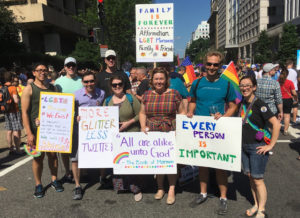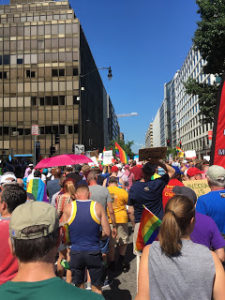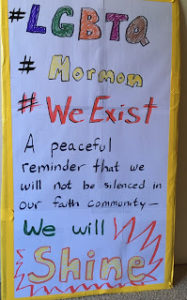Affirmation Pride in DC Celebrates Intersectionality, Shared Struggle and Resilience

By MC
The LGBTQ+ community is inherently intersectional and our struggle is shared and our resilience unrelenting.
DC Capital Pride may be more like a parade than a protest, but for many, visibility is still an act of protest. I started marching in the parade with Affirmation and Mormons Building Bridges. It was integral in my process of being honest and authentic about who I am.
In the past five years of making it out to Capital Pride, I have asked myself: Do I post these pictures on social media? Will people I work with see it? Do I post this vlog from Pride? My students could see it. What if someone from church sees it? Is it okay to share this picture of my friend at the parade? Will my family just assume that I’m there as an ally? Should I let them just assume that?
I went back to look at pictures from past years, and I noticed that I dodged several group pictures. This year, I didn’t ask myself so many questions. I wore a shirt with Cheer Bear in front of a bright, glittery rainbow. I bought the rainbow bandanna that I’ve wanted for the past 5 years. I put on a complete rainbow selection of beads during the parade and I headed back for the LGBT Equality March on Washington.
These were some of the phrases that struck me the most:
- Existence is resistance.
- A peaceful reminder that we will not be silenced in our faith communities.
- It’s not just about bathrooms just like it wasn’t just about water fountains.
- We have stood in solidarity with you. We ask you to stand in solidarity with us.
As a fairly feminine woman, no one would know I was bisexual unless I told them. My coworkers think my gender neutral pronouns are just a product of my liberal upbringing. Or, maybe they think I’m being funny. My friends at church assume I’m an ally. My family assumed I was always going to support a friend. I think that at times I have too often been complicit in my own bierasure. Though, I remind myself that it is not my fault that people see what they want to see. Also, everyone has their own journey.
It meant a lot to me to hear the brief but powerful comments of Sara Ramirez about visibility and bi-representation. She spoke directly to the bisexual experience:
“Our experience makes people uncomfortable…[deemed by some] as not gay enough or not straight enough…having chosen a side [or] damaging to the cause. Our very existence threatens hetereonormativity and the gender binary.”
Other speakers represented the varied experiences of the LGBTQ+ community: an African American trans woman who has overcome youth homelessness, a gay immigrant from Guatemala whose mother gave up her job and home to move to a country where her son could live a more authentic life, and a two spirit water defender from Standing Rock. The focus on intersectionality could have felt contrived, but it didn’t. Because, the LGBTQ+ community is inherently intersectional. Like Sara Ramirez said, “[Our] stand for equality has never been about just one person, just one lived experience, or one identity. Our struggle is shared and our resilience unrelenting.” The intersectionality was well thought out as well as thoughtful.
This Pride was a powerful commemoration of its roots, those we have lost, and the authenticity of who we are. It’s not enough that people are fine with us as long as they don’t have to see us. This pride was a powerful commemoration of its roots, those we have lost, and the authenticity of who we are.




